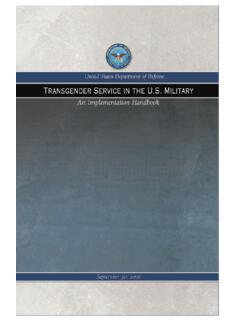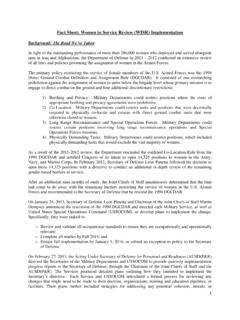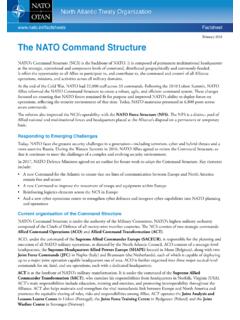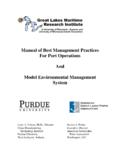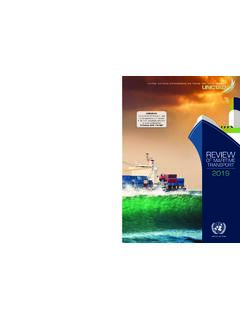Transcription of ASIA-PACIFIC - U.S. Department of Defense
1 ASIA-PACIFICM aritime Security Strategy This page left intentionally blank The ASIA-PACIFIC maritime Security Strategy: Achieving National Security Objectives in a Changing Environment In accordance with Section 1259 of the Carl Levin and Howard P. Buck McKeon National Defense Authorization Act for Fiscal Year 2015, Public Law 113-291, this report outlines the Department of Defense s strategy with regard to maritime security in the ASIA-PACIFIC region. Recognizing the importance of the ASIA-PACIFIC region and its maritime domain for the security of the United States, the Department is focused on safeguarding freedom of the seas, deterring conflict and coercion, and promoting adherence to international law and standards. As it does around the world, the Department will continue to fly, sail, and operate wherever international law allows, in support of these goals and in order to preserve the peace and security the ASIA-PACIFIC region has enjoyed for the past 70 years.
2 Recognizing the growing complexity of the ASIA-PACIFIC maritime domain, this report outlines four lines of effort the Department is employing in order to preserve security in this vital region. First, we are strengthening our military capacity to ensure the United States can successfully deter conflict and coercion and respond decisively when needed. Second, we are working together with our allies and partners from Northeast Asia to the Indian Ocean to build their capacity to address potential challenges in their waters and across the region. Third, we are leveraging military diplomacy to build greater transparency, reduce the risk of miscalculation or conflict, and promote shared maritime rules of the road. Finally, we are working to strengthen regional security institutions and encourage the development of an open and effective regional security architecture.
3 Together with our inter-agency colleagues and regional allies and partners, the Department is focused on ensuring that maritime Asia remains open, free, and secure in the decades ahead. The estimated cost of this report or study for the Department of Defense is approximately $84,000 for the 2015 Fiscal Year. This includes $5,000 in expenses and $79,000 in DoD labor. Generated on 2015 Jul27 RefID: F-79748EF The ASIA-PACIFIC maritime Security Strategy 1 UNCLASSIFIED Draft Deliberative Document//Not Subject to FOIA Release The ASIA-PACIFIC maritime Security Strategy 1 ACHIEVING NATIONAL SECURITY OBJECTIVES IN A CHANGING ENVIRONMENT INTRODUCTION he United States has enduring economic and security interests in the ASIA-PACIFIC region. And because the region stretching from the Indian Ocean, through the South and East China Seas, and out to the Pacific Ocean is primarily water, we place a premium on maintaining maritime peace and security.
4 To that end, the Department of Defense has three maritime objectives in the ASIA-PACIFIC region: to safeguard the freedom of the seas; deter conflict and coercion; and promote adherence to international law and standards. Why We Safeguard the Freedom of the Seas The United States has, throughout its history, advocated for the freedom of the seas for economic and security reasons. maritime Asia is a vital thruway for global commerce, and it will be a critical part of the region s expected economic growth. The United States wants to ensure the ASIA-PACIFIC region s continued economic progress. The importance of ASIA-PACIFIC sea lanes for global trade cannot be overstated. Eight of the world s 10 busiest container ports are in the ASIA-PACIFIC region, and almost 30 percent of the world s maritime trade transits the South China Sea annually, including approximately $ trillion in ship-borne trade bound for the United Approximately two-thirds of the world s oil shipments transit through the Indian Ocean to the Pacific, and in 2014, more than 15 million barrels of oil passed through the Malacca Strait per day.
5 1 Energy Information Administration. 1 Energy Information Administration. T The Department of Defense has three maritime objectives in the ASIA-PACIFIC region: to safeguard the freedom of the seas; deter conflict and coercion; and promote adherence to international law and standards. The ASIA-PACIFIC maritime Security Strategy 2 ACHIEVING NATIONAL SECURITY OBJECTIVES IN A CHANGING ENVIRONMENT "Freedom of the seas" means all of the rights, freedoms, and lawful uses of the sea and airspace, including for military ships and aircraft, recognized under international law. Freedom of the seas, however, includes more than the mere freedom of commercial vessels to transit through international waterways. While not a defined term under international law, the Department uses freedom of the seas to mean all of the rights, freedoms, and lawful uses of the sea and airspace, including for military ships and aircraft, recognized under international law.
6 Freedom of the seas is thus also essential to ensure access in the event of a crisis. Conflicts and disasters can threaten interests and those of our regional allies and partners. The Department of Defense is therefore committed to ensuring free and open maritime access to protect the stable economic order that has served all ASIA-PACIFIC nations so well for so long, and to maintain the ability of forces to respond as needed. Why We Deter Conflict and Coercion For 70 years, military presence in the ASIA-PACIFIC region has played a vital role in undergirding regional peace, stability, and security. This presence has enabled tremendous prosperity and economic growth across the region and facilitated the unimpeded flow of resources and trade across vital Asian waterways.
7 It is in the interests of all nations, not only those in the ASIA-PACIFIC region, that the United States continues to deter and prevent conflict in this critical region. As the maritime security environment continues to evolve, this task is becoming more challenging. But there should be no doubt that the United States will maintain the necessary military presence and capabilities to protect our interests and those of our allies and partners against potential threats in the maritime domain. Why We Promote Adherence to International Law and Standards Adherence to a rules-based system has been critical to furthering peace, stability, and prosperity in the ASIA-PACIFIC region. This system provides the basis for shared use of maritime waterways and resources, and ensures safe operations within the maritime domain.
8 This is why the United States operates consistent with even though the Senate has yet to provide its advice and consent the United Nations Convention on the Law of the Sea (Law of the Sea Convention), which reflects customary international law with respect to traditional uses of the ocean. The Department of Defense , in conjunction with interagency partners, regional institutions, and regional allies and partners, is working to ensure that the rule of law not coercion and force dictate maritime Asia s future. The ASIA-PACIFIC maritime Security Strategy 3 ACHIEVING NATIONAL SECURITY OBJECTIVES IN A CHANGING ENVIRONMENT For decades, the ASIA-PACIFIC region has remained free from major conflicts, allowing nations to continue enjoying the benefits of the maritime domain.
9 The ASIA-PACIFIC maritime Security Strategy 4 ACHIEVING NATIONAL SECURITY OBJECTIVES IN A CHANGING ENVIRONMENT The ASIA-PACIFIC maritime Security Strategy 5 ACHIEVING NATIONAL SECURITY OBJECTIVES IN A CHANGING ENVIRONMENT STRATEGIC CONTEXT or decades, the ASIA-PACIFIC region has remained free from major conflicts, allowing nations to continue enjoying the benefits of the maritime domain. However, the security environment is changing, potentially challenging the continued stability of the region. Rapid economic and military modernization, combined with growing resource demands, has exacerbated the potential for conflict over long-standing territorial disputes. In addition, non-traditional threats such as weapons proliferation, human and other illicit trafficking, piracy, and natural disasters continue to pose significant security challenges.
10 On the other hand, we have seen a number of positive trends in recent years as well, including the peaceful resolution of some maritime disputes in the region. [1] Competing Territorial and maritime Claims There are numerous, complex maritime and territorial disputes in the ASIA-PACIFIC region. The presence of valuable fish stocks and potential existence of large hydrocarbon resources under the East and South China Seas exacerbate these complicated claims. A United Nations report estimates that the South China Sea alone accounts for more than 10 percent of global fisheries production. Though figures vary substantially, the Energy Information Administration estimates that there are approximately 11 billion barrels and 190 trillion cubic feet of proved and probable oil and natural gas reserves in the South China Sea and anywhere from one to two trillion cubic feet of natural gas reserves, and 200 million barrels of oil in the East China Sea.



